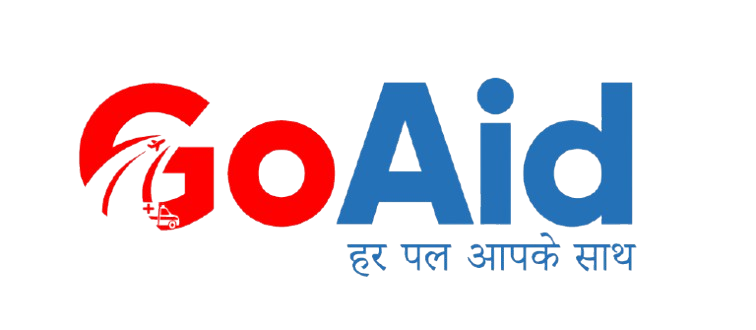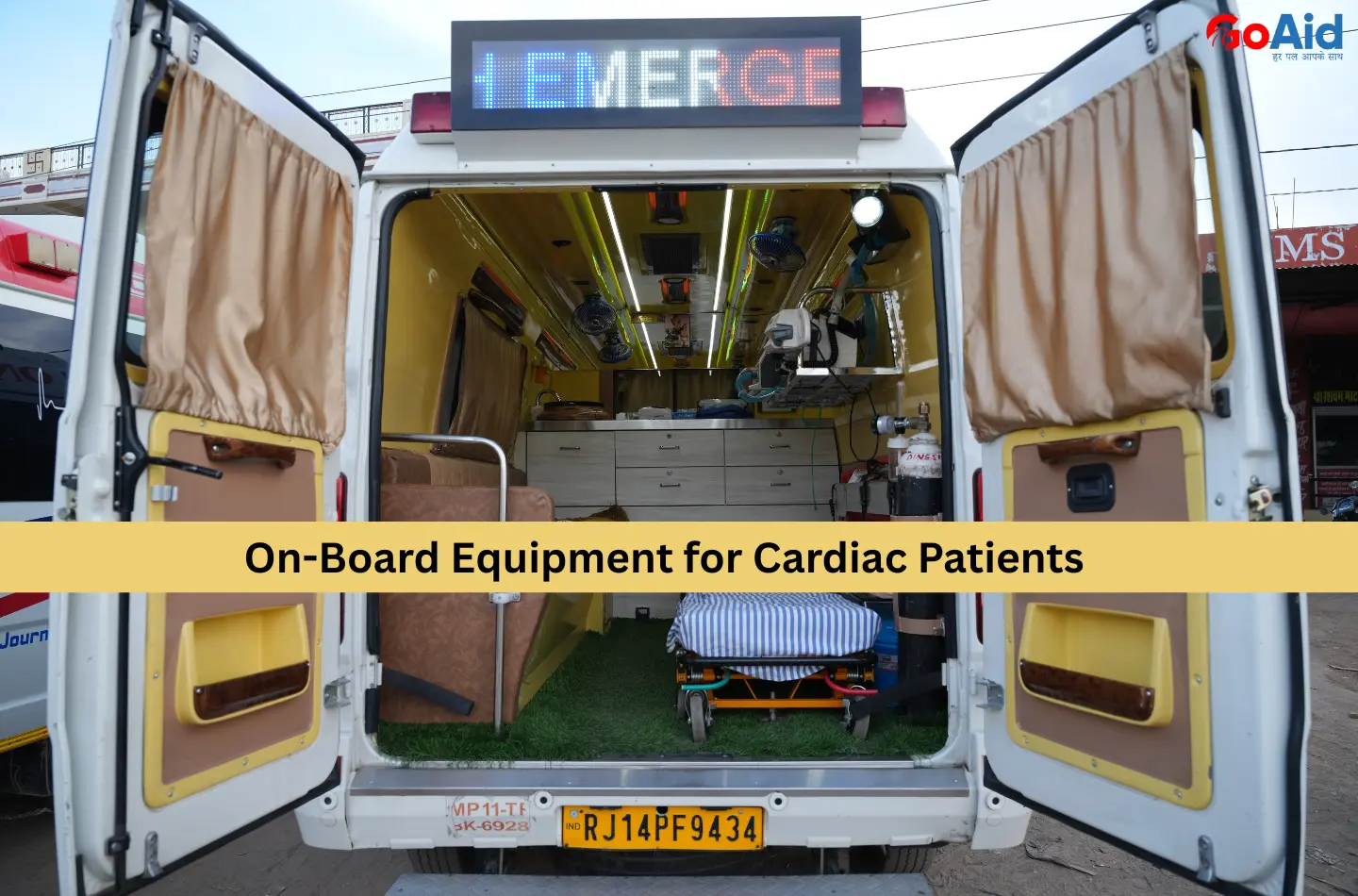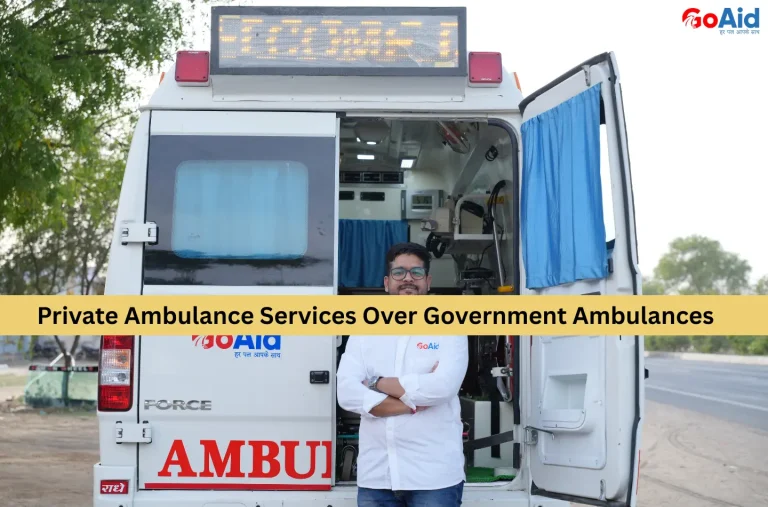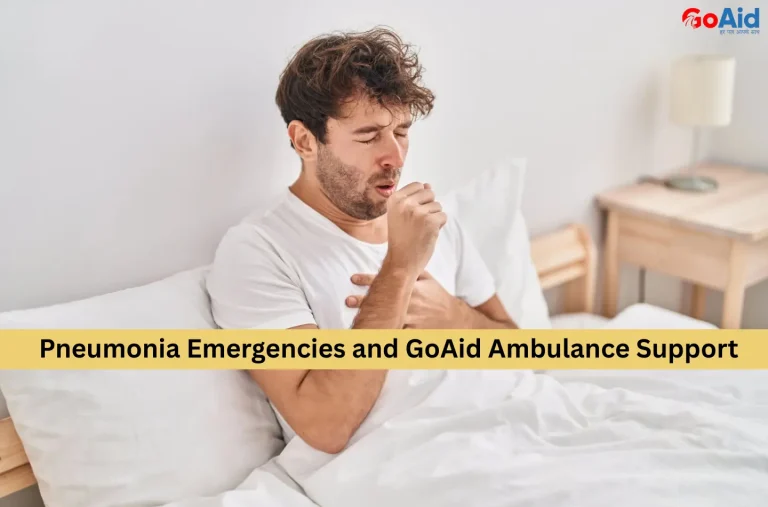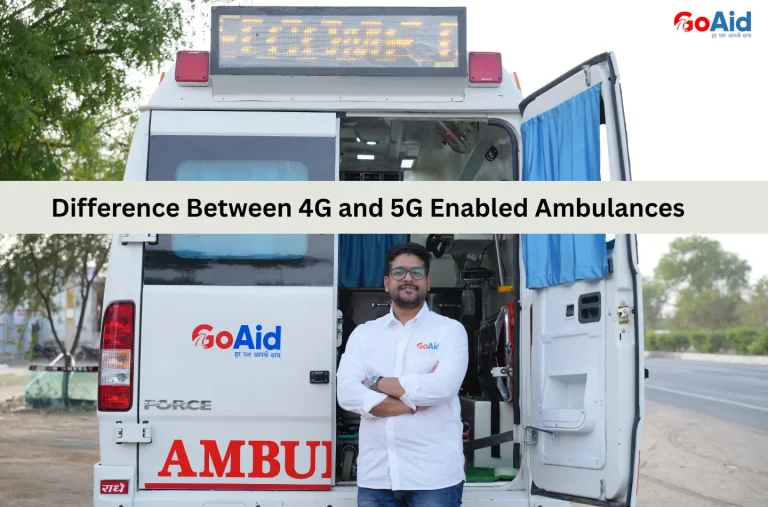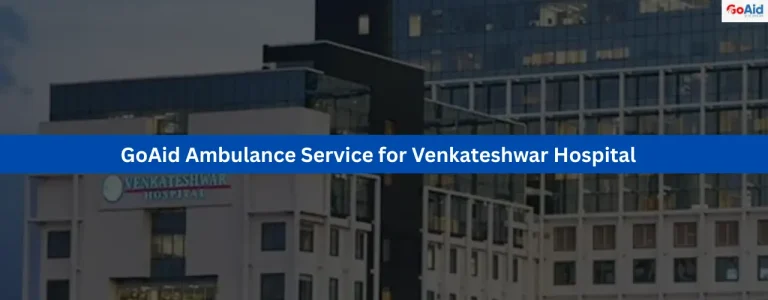Cardiac emergencies are extremely time-sensitive, and even a few minutesŌĆÖ delay can put a patientŌĆÖs life at risk. Many families struggle to recognize critical symptoms or access properly equipped ambulances. This makes it vital to understand why fast, specialized ambulance services are essential for heart patients.
This is why, in this blog we have provided you with all the details about why every second matters during cardiac emergencies, the importance of ECG and monitoring equipment, the role of ACLS-trained paramedics, how fast ambulances reduce fatalities, common mistakes families make, and how GoAid offers specialized cardiac ambulance services. Do you want to know all these information in detail? then read our blog to the end.
So, lets start
Why Cardiac Patients Are Much Sensitive to Handle With Care?
Cardiac patients require careful handling because even minor shocks, delays, or stress can worsen their condition. Proper support ensures stability, prevents complications, and improves survival during transport or emergencies.
1. Fragile Heart Function
Cardiac patients often have weakened heart muscles. This makes them highly sensitive to physical strain or sudden movements during transport.
2. Risk of Arrhythmias
Improper handling or stress can trigger irregular heart rhythms, potentially leading to life-threatening conditions without immediate intervention.
3. Blood Pressure Fluctuations
Rapid or rough movement may cause dangerous spikes or drops in blood pressure. This increases the risk of heart attack or stroke.
4. Vulnerability to Chest Pain
Even minor jolts during transit can provoke chest discomfort, angina, or worsening heart pain. This requires immediate medical attention.
5. Sensitivity to Stress & Anxiety
Cardiac patients react strongly to emotional stress; calm, professional handling reduces heart strain and prevents further complications.
6. High Risk During Sudden Emergency Movements
Transport in non-specialized vehicles increases chances of jolts or falls, which can severely affect a patientŌĆÖs cardiac stability.
7. Need for Continuous Monitoring
Cardiac patients require real-time monitoring of ECG, oxygen levels, and vitals; improper handling can prevent effective observation.
8. Risk of Heart Attack Recurrence
Even after stabilization, improper care or handling during movement may trigger another cardiac episode.
9. Medication Sensitivity
Patients often depend on time-sensitive medications; delays or improper support can interfere with drug efficacy, worsening heart conditions.
10. Critical Response Timing
Every action, from lifting to transport, must be controlled and precise. This ensures the patient reaches medical care without added risk.
Why Every Second Matters in Cardiac Emergencies?
In cardiac emergencies, such as heart attacks or sudden arrhythmias, minutes can mean the difference between life and death. The heart muscle is extremely sensitive to oxygen deprivation, and delayed care increases the risk of irreversible damage.
Rapid ambulance response ensures early diagnosis, on-board ECG monitoring, and administration of critical medications or defibrillation if needed. Advanced Cardiac Life Support (ACLS) paramedics can stabilize the patient en route, manage arrhythmias, and provide oxygen therapy, significantly improving survival chances.
Transporting patients in non-specialized vehicles often lacks monitoring, medical equipment, and trained personnel, delaying essential interventions. Families must recognize early warning signs,chest pain, dizziness, breathlessness,and call a cardiac ambulance immediately.┬Ā
Fast action reduces complications, prevents heart muscle damage, and increases the probability of a full recovery. For cardiac patients, every second counts, and specialized ambulance care ensures timely, professional support from pick-up to hospital admission.
Symptoms That Require Immediate Ambulance Support to a Cardiac Patient
Cardiac emergencies demand fast medical attention. Recognizing critical symptoms early and calling an ambulance immediately can save lives and prevent severe heart damage during transport or delays.
1. Severe Chest Pain
Intense chest pressure, tightness, or crushing pain may indicate a heart attack. Immediate ambulance support ensures rapid treatment and monitoring during transit.
2. Shortness of Breath
Difficulty breathing, rapid or labored breathing signals cardiac distress. Oxygen therapy and paramedic care en route can prevent deterioration.
3. Dizziness or Fainting
Sudden dizziness or loss of consciousness may indicate arrhythmias or low blood flow. This requires immediate professional intervention.
4. Palpitations or Irregular Heartbeat
Rapid, fluttering, or irregular heartbeat can precede cardiac arrest. This makes ambulance transport with monitoring essential.
5. Sweating & Nausea
Excessive sweating, nausea, or vomiting can accompany heart attacks, signaling the need for urgent medical attention.
6. Pain Radiating to Arm, Neck, or Jaw
Discomfort spreading to the arm, neck, or jaw is a warning sign of heart-related issues. This requires rapid transport.
7. Weakness or Fatigue
Sudden extreme fatigue or inability to perform simple tasks may indicate inadequate heart function needing prompt monitoring.
8. Anxiety or Sense of Impending Doom
Unexplained anxiety often accompanies cardiac events; ambulance intervention ensures safe evaluation and treatment.
9. Low Blood Pressure or Faint Pulse
Drop in vitals indicates cardiovascular instability. Ambulances provide continuous monitoring and emergency stabilization.
10. Loss of Consciousness
Unresponsiveness is an immediate red flag; paramedics provide life-saving measures and rapid hospital transfer.
Also Read: Importance of School Ambulances
Importance of ECG & Monitoring Equipment in Cardiac Ambulances
ECG and monitoring equipment are critical in cardiac ambulances to detect arrhythmias, track heart function, and provide immediate interventions. This improves survival chances during emergencies.
1. Continuous Heart Rhythm Monitoring
ECG tracks cardiac rhythm in real time, alerting paramedics to irregularities that could trigger life-threatening events.
2. Detects Myocardial Infarction Early
Monitoring identifies early heart attack signs. This enables prompt treatment before severe heart muscle damage occurs.
3. Guides Medication Administration
Continuous monitoring allows paramedics to adjust oxygen, anti-arrhythmic, or other emergency drugs accurately for patient safety.
4. Provides Real-Time Data to Hospitals
Some ECG systems transmit data ahead to hospitals. This enables immediate preparation for treatment on arrival.
5. Supports ACLS Procedures
Advanced cardiac life support relies on real-time vitals and ECG readings to perform interventions safely during transit.
6. Detects Blood Pressure Fluctuations
Monitoring equipment tracks rapid BP changes. This helps paramedics stabilize patients and prevent sudden complications.
7. Tracks Oxygen Saturation Levels
Pulse oximeters ensure patients maintain proper oxygenation, crucial for preventing cardiac tissue damage.
8. Assists in Post-Attack Care
Monitoring ensures ongoing observation of patients recovering from heart events during ambulance transport.
9. Reduces Risk During Transfers
Real-time data alerts paramedics to deterioration. This allows corrective actions before hospital arrival.
10. Improves Survival Rates
Early detection and intervention facilitated by ECG and monitoring devices significantly increase cardiac emergency survival chances.
Role of ACLS-Trained Paramedics
ACLS-trained paramedics provide advanced cardiac life support during emergencies. This ensures rapid assessment, stabilization, and continuous monitoring, which is critical for improving patient outcomes during heart attacks and severe cardiac events.
1. Immediate Life-Saving Interventions
ACLS paramedics can administer defibrillation, medications, and oxygen therapy immediately, preventing cardiac arrest progression and stabilizing the patient en route to the hospital.
2. Advanced Airway Management
They secure the patientŌĆÖs airway using techniques like intubation. This ensures proper oxygen supply, especially during severe respiratory distress or unconsciousness.
3. Continuous ECG Monitoring
Paramedics monitor heart rhythm in real time, detecting arrhythmias or ischemic changes, and take corrective action before the patient deteriorates further.
4. Timely Administration of Medications
They can provide anti-arrhythmic drugs, pain relievers, and clot-busting agents safely. This ensures rapid therapeutic response during transit.
5. Efficient Trauma & Shock Management
ACLS-trained personnel handle hypotension, shock, or trauma-related cardiac complications, preventing further organ damage before hospital admission.
6. Communication With Hospitals
They provide real-time updates to the receiving hospital. This enables the medical team to prepare for immediate treatment upon arrival.
7. Patient Stabilization Under Stress
Trained paramedics maintain calm and structured care. This reduces patient anxiety and controlling vitals during emergencies.
How Fast Ambulances Reduce Heart Attack Fatalities?
Fast ambulance response dramatically lowers fatalities in heart attacks by delivering patients to hospitals quickly and providing early interventions. On-board equipment allows immediate ECG monitoring, oxygen therapy, and defibrillation if required.
ACLS-trained paramedics begin life-saving measures within minutes, preventing cardiac tissue damage. Rapid transport ensures timely administration of clot-busting medications or other emergency treatments. Studies show that every minute saved during a heart attack significantly improves survival rates.
Private services like GoAid with GPS-enabled rapid dispatch, specialized cardiac ambulances, and trained paramedics reduce critical delays. This ensures patients receive professional care without wasting precious time, ultimately improving outcomes and minimizing complications.
Why Cardiac Patients Cannot Be Transported in Normal Vehicles
Transporting heart patients in regular cars or taxis is unsafe due to lack of monitoring, equipment, and professional care, which can worsen cardiac emergencies.
1. No On-Board Medical Equipment
Normal vehicles lack ECG monitors, oxygen supply, defibrillators, or medications. This makes it impossible to respond to sudden cardiac complications during transit.
2. Absence of Trained Personnel
Without ACLS-trained paramedics, patients cannot receive immediate life-saving interventions. This increases the risk of fatal outcomes en route.
3. Unsafe Driving Conditions
Sudden braking, uneven roads, or unprepared handling can trigger arrhythmias or worsen chest pain, which specialized ambulances manage safely.
4. Delay in Hospital Communication
Normal vehicles cannot provide real-time updates to hospitals, delaying preparation for emergency treatment upon arrival.
5. Inability to Stabilize Critical Conditions
Heart attack patients often require continuous monitoring and intervention; normal cars cannot provide safe stabilization or emergency care during transport.
How GoAid Offers Specialized Care With Cardiac Ambulance Services
GoAid provides specialized cardiac ambulance services designed to deliver immediate, professional care for heart patients. Their ambulances are fully equipped with ECG monitors, oxygen supply, ventilators, defibrillators, and emergency drug kits. This enables real-time treatment during transport.
ACLS-trained paramedics monitor vitals continuously, manage arrhythmias, and administer life-saving medications en route to the hospital. GPS-enabled rapid dispatch ensures the fastest possible response. This reduces critical delays that can worsen heart conditions.┬Ā
GoAid also coordinates with hospitals to pre-inform medical teams. This ensures uninterrupted admission and treatment. Their vehicles are designed for patient comfort, stability, and safety. This minimizes stress and risk during transit. Families receive clear communication about patient status, procedures, and estimated arrival times.
This combination of advanced equipment, expert personnel, and operational efficiency makes GoAid a trusted provider for cardiac emergencies. This improves survival rates and ensuring that patients receive top-quality pre-hospital care when every second counts.
Common Mistakes Families Make During Cardiac Attacks
During cardiac emergencies, family members often make critical errors that delay care or worsen the patientŌĆÖs condition. Avoiding these mistakes can significantly improve outcomes.
1. Delaying Ambulance Call
Waiting to ŌĆ£see if symptoms passŌĆØ wastes precious time. This reduces survival chances during heart attacks. Immediate medical response is crucial.
2. Transporting in Private Vehicles
Using cars or taxis is unsafe due to a lack of monitoring and medical support, risking sudden deterioration en route to the hospital.
3. Ignoring Early Symptoms
Chest pain, dizziness, or shortness of breath should never be underestimated. Delaying recognition leads to complications.
4. Panic-Induced Mistakes
Family panic can cause unsafe handling, improper positioning, or wrong medication administration. This increases cardiac stress.
5. Administering Incorrect Medication
Giving non-prescribed drugs or excessive aspirin without guidance can harm the patient or interfere with hospital treatment.
6. Not Notifying the Hospital
Failing to inform the receiving hospital prevents early preparation and delays critical interventions upon arrival.
7. Lack of Basic First Aid Knowledge
Not knowing CPR, oxygen usage, or proper patient positioning can worsen outcomes before paramedic arrival.
8. Overcrowding Around the Patient
Too many people around the patient increases stress, reduces space for care, and hampers effective first aid.
9. Ignoring Medical History
Failing to share past heart conditions, medications, or allergies can lead to suboptimal treatment during emergencies.
10. Hesitating on Emergency Action
Even small delays in calling trained paramedics or initiating emergency protocols can significantly impact heart attack survival.
Benefits of Pre-Hospital Stabilization
Immediate pre-hospital care by trained paramedics significantly improves survival rates and reduces complications for cardiac patients during emergencies.
1. Early ECG Monitoring
Paramedics detect arrhythmias and ischemic changes. This enables rapid intervention before hospital arrival.
2. Oxygen Support
Providing oxygen en route prevents tissue damage and maintains vital organ function.
3. Controlled Medication Administration
Emergency drugs are given accurately. This stabilizes blood pressure, heart rhythm, and chest pain.
4. Immediate Defibrillation if Needed
On-board defibrillators allow life-saving shock delivery during sudden cardiac arrest.
5. Patient Stabilization
Proper positioning and monitoring reduce physical stress, lowering risk of worsening heart conditions.
6. Real-Time Hospital Communication
Pre-arrival data transmission ensures hospitals are prepared for immediate intervention.
7. Continuous Vital Monitoring
Paramedics track heart rate, blood pressure, and oxygen saturation, preventing unnoticed deterioration.
8. Reduces Complications
Early stabilization minimizes the risk of heart muscle damage or multi-organ failure.
9. Enhances Patient Comfort
Professional care and smooth transport reduce stress and anxiety. This improves outcomes.
10. Increases Survival Rates
Overall, pre-hospital care significantly boosts the chances of recovery and lowers mortality in time-sensitive cardiac emergencies.
When to Call a Cardiac Ambulance Immediately?
Recognizing the signs of a cardiac emergency early and calling a specialized ambulance immediately can save lives and prevent severe complications during transport.
1. Severe Chest Pain or Pressure
Intense, crushing, or tight chest pain ,especially radiating to the arm, neck, or jaw ,requires immediate ambulance intervention for quick stabilization and transport.
2. Shortness of Breath
Difficulty breathing or rapid breathing indicates reduced oxygen supply to the heart, demanding urgent professional care and monitoring.
3. Sudden Dizziness or Fainting
Loss of consciousness or severe dizziness may signal arrhythmias or low blood flow. This requires immediate paramedic support.
4. Rapid or Irregular Heartbeat
Palpitations or fluttering heartbeats could precede cardiac arrest; calling a cardiac ambulance ensures continuous monitoring en route.
5. Sweating, Nausea, or Vomiting
Excessive perspiration and nausea often accompany heart attacks and need urgent professional intervention to prevent deterioration.
6. Weakness or Extreme Fatigue
Sudden inability to perform basic tasks or extreme weakness signals a serious cardiac event needing rapid response.
7. Low Blood Pressure or Faint Pulse
Rapid drops in vital signs require immediate ambulance support with equipment for stabilization and monitoring during transport.
The Most Trusted Helpline for Cardiac Patients to Call
For cardiac emergencies, the most trusted helpline in India is 8008280020, provided by GoAid Ambulance Service. This number connects patients and families to trained paramedics instantly. This ensures rapid dispatch of ECG-equipped, ACLS-ready cardiac ambulances.
By calling 8008280020, families receive real-time guidance, pre-arrival instructions, and immediate medical support. GoAid paramedics are professionally trained to stabilize patients, administer emergency medications, monitor vitals, and coordinate with hospitals en route, significantly improving survival chances.┬Ā
This dedicated helpline ensures quick, reliable, and safe cardiac emergency response, giving families confidence that expert care is just a phone call away.
Conclusion
In conclusion, we have provided all the information about why cardiac patients require fast ambulance services with on-board equipment. From recognizing early symptoms to the importance of ACLS-trained paramedics, ECG monitoring, and pre-hospital stabilization, every second counts in saving lives.
Specialized cardiac ambulances, like those provided by GoAid, ensure rapid response, advanced care, and safe transport. This reduces complications and improving survival rates.
Families must act promptly, call emergency services, and rely on trained professionals to manage time-sensitive cardiac emergencies effectively.
FAQs
Q1: When should I call a cardiac ambulance for a heart patient?
A: You should call a cardiac ambulance immediately if the patient experiences severe chest pain, shortness of breath, dizziness, irregular heartbeat, or any other heart attack symptoms. GoAid Ambulance Service ensures rapid response.
Q2: What equipment do cardiac ambulances carry for emergencies?
A: ECG monitors, defibrillators, oxygen supply, ventilators, emergency drugs, and other advanced life-support devices are onboard to stabilize patients en route, provided by services like GoAid Ambulance Service.
Q3: How do ACLS-trained paramedics help during cardiac emergencies?
A: ACLS paramedics provide life-saving interventions, monitor vital signs, administer medications, manage arrhythmias, and communicate with hospitals to ensure timely, professional care during patient transport.
Q4: Can I transport a heart patient in a normal vehicle?
A: No, normal vehicles lack monitoring equipment, trained personnel, and emergency interventions. Specialized cardiac ambulances like GoAid are essential for safe, professional transport.
Q5: What is the most trusted helpline for cardiac emergencies in India?
A: The trusted helpline is 8008280020. This connects patients to GoAid Ambulance Service, which provides rapid dispatch, ECG-equipped ambulances, ACLS paramedics, and professional pre-hospital cardiac care.
